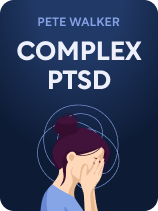

This article is an excerpt from the Shortform book guide to "Complex PTSD" by Pete Walker. Shortform has the world's best summaries and analyses of books you should be reading.
Like this article? Sign up for a free trial here.
How do you recover after repeated trauma and abuse? Can complex PTSD be treated?
Healing from complex PTSD starts with greater self-awareness and self-acceptance. Victims of abuse often feel ashamed and perfectionistic, and healing requires a rewiring of this mindset.
Continue reading for more on how to heal from trauma.
Developing Self-Awareness and Self-Acceptance
Because shame and perfectionism are major symptoms of CPTSD, an important part of healing from complex PTSD is to develop a healthy sense of self. In other words, people with CPTSD need to learn—or relearn—how to identify their needs and ensure those needs are met.
This is necessary because a common abuse tactic is to shame or frighten the victim out of their self-loving and self-protective feelings. For example, an abusive spouse might call their partner selfish for expressing personal needs and wants; an abusive parent might hit their children for trying to stand up for themselves. Eventually, the victim learns that the only way to stay (relatively) safe is to always put their abuser’s desires before their own.
| Why and How Abusers Destroy Someone’s Sense of Self Abuse victims eventually learn to place their abuser’s wants and needs before their own. In Why Does He Do That?, Bancroft goes a step further: He says that getting someone to place their abuser’s wants and needs before their own is the entire purpose of abuse. While abusers use many different tactics to accomplish their goals—such as tearing down any attempt by their victims to stand up for themselves—Bancroft divides abusive behaviors into just two categories: The first category is intimidation, where the abuser frightens their victim into submission by hurting them or threatening to hurt them. Physical violence (or the threat of it) is one form of intimidation, but this category also includes acts such as damaging the victim’s reputation, taking control of their finances, and making threats against their family or other loved ones. The second category is manipulation, where an abuser convinces the victim to doubt their own thoughts, feelings, and beliefs in favor of whatever the abuser wants them to think, feel, and believe. One example of this is repeatedly telling someone that they’re too stupid to know what they want, or insisting on what’s morally right in a given situation; eventually, the victim becomes dependent on the abuser to tell them what to do. |
Cultivating Mindfulness
Walker adds that developing a healthy sense of self eventually leads to mindfulness: the capacity to understand and accept yourself as you currently are. Phrased differently, mindfulness is the combination of comprehension and compassion. Practicing mindfulness helps people to observe their moment-to-moment thoughts and impulses, identify them, and rationally decide how to respond to them.
(Shortform note: This explanation of mindfulness is a bit different from its usual meaning, which involves awareness but not necessarily compassion. In Radical Acceptance, psychologist Tara Brach defines mindfulness as recognizing and understanding one’s moment-to-moment thoughts, emotions, and physical sensations without feeling compelled to act on them. For instance, a mindful person might recognize that they feel uncomfortable in a social situation, but not feel like they need to escape from that situation immediately—they can first consider why they feel uncomfortable, then make a rational choice about whether to stay or go. Note that Brach does consider self-compassion to be part of a healthy mindset, she just doesn’t include it as part of mindfulness.)
Mindfulness is a crucial skill for people with CPTSD to develop. This is because mindfulness will allow them to recognize which thoughts come from their overactive self-judgment and which are actually appropriate for the current situation. Mindfulness will also allow them to make rational, healthy decisions about what to do, instead of impulsively reacting to their fears of punishment or abandonment.
For example, someone who’s being treated unfairly at work might experience the feeling of shame and the belief that it’s their own fault. By practicing mindfulness, they could recognize that those are trauma-induced thought patterns and that anger would be a justified, healthy response to such unfair treatment. They could then make the rational decision to report the situation to HR.
Emotionally Recovering From CPTSD
Healing from the psychological impacts of trauma is a large part of recovery. However, for a survivor to fully develop or regain their sense of self, they must also reconnect with the emotions that their abusers forced them to repress.
Abusers often punish and shame their victims for expressing negative emotions like sadness or anger. As a result, trauma survivors tend to repress those feelings, which can cause two serious problems:
First, trying to avoid unpleasant or “forbidden” emotions makes people unable to process those feelings and move on from them. Therefore, paradoxically, people who try to avoid feeling negative emotions often get stuck in negative emotional states for a much longer time. To illustrate this idea, picture negative feelings like a so-called Chinese finger trap: The harder someone struggles to escape, the more tightly the negative feelings hold them.
(Shortform note: The effects of repressing emotions can be much more severe than just feeling worse for a longer time—those unprocessed feelings keep accumulating, eventually becoming a source of intense stress and even psychiatric disorders like anxiety and depression. Emotionally repressed people also tend to have a hard time forming meaningful relationships; they’re not able to be open and honest about their own feelings, and they’re often uncomfortable when people express strong emotions. As a result, they form only shallow and distant connections with others, rather than creating meaningful and supportive relationships.)
Second, repressing some emotions often leads to repressing all emotions. In other words, in trying to avoid feeling sad or angry, the survivor becomes unable to feel anything. This leaves them unable to enjoy the good things in life, and often makes it difficult for them to make even simple decisions; without emotions guiding them, they don’t know what they want.
This emotional deadening is also a safety concern because negative emotions are clues that something’s wrong. Therefore, without feelings like fear and anger to warn them of potential problems, the survivor may not be able to recognize when they’re in danger or are being treated unfairly.
(Shortform note: The emotional deadening described here—also known as emotional numbness or emotional blunting—can cause a person to lose interest in everything from hobbies to friends, and even their significant other. Scientists aren’t sure why blocking out negative feelings can dull a person’s entire emotional spectrum in this way, but some research suggests that it’s because the brain’s methods for suppressing emotions can’t distinguish between “good” and “bad” feelings. For instance, one hypothesis is that people subconsciously avoid noticing what’s around them, thereby shutting out things that would spark both positive and negative emotions.)
Society reinforces this type of emotional trauma. In many places, it’s not culturally acceptable to show negative emotions. Also, media constantly bombards people with messages that they should be happy and cheerful all the time. Much like an abusive parent or partner, these cultural influences condition people to repress their feelings and only express the “right” emotions—which makes it even harder for people with CPTSD to recover emotionally.
(Shortform note: Encouraging people to be happy at all times is known as toxic positivity. It’s called toxic because, even when well-intentioned, such forced positivity dismisses people’s real feelings and glosses over genuine problems. Also, with the growth of social media, toxic positivity has become much more common. For instance, people will share posts with simplistic advice like “Choose happiness,” as though people aren’t happy just because they’ve decided not to be. In short, toxic positivity insists that everyone should always feel good but ignores the reasons why people are unhappy in the first place. Even worse, it often sends the message that people’s unhappiness is their own fault; for someone with CPTSD, such messages could echo their abuser’s victim-blaming tactics.)
The end goal of emotional recovery is for the survivor to develop emotional intelligence: the ability to recognize emotions in themselves and others, accept those emotions for what they are, and respond to them in a healthy way. In this section, we’ll explain why Walker believes that grief is the most effective way to develop these skills, and we’ll describe what the grieving process looks like for a trauma survivor.
(Shortform note: In addition to helping trauma survivors reconnect with their feelings, emotional intelligence is also useful in the workplace, especially for people in leadership positions. Therefore, developing emotional intelligence can also help people with CPTSD to advance in their careers and thus build better lives for themselves. It’s useful for leaders because when people understand how their own emotions can affect their judgment, it helps them make more objective, rational decisions. People with high emotional intelligence also tend to be more proficient at communication, teamwork, and conflict resolution—all crucial skills for someone in a leadership position.)

———End of Preview———
Like what you just read? Read the rest of the world's best book summary and analysis of Pete Walker's "Complex PTSD" at Shortform.
Here's what you'll find in our full Complex PTSD summary:
- A guide to recognizing Complex Post-Traumatic Stress Disorder
- How to recover using physical, psychological, emotional, and social healing
- Why it's so important to accept and appreciate things that are "good enough"






